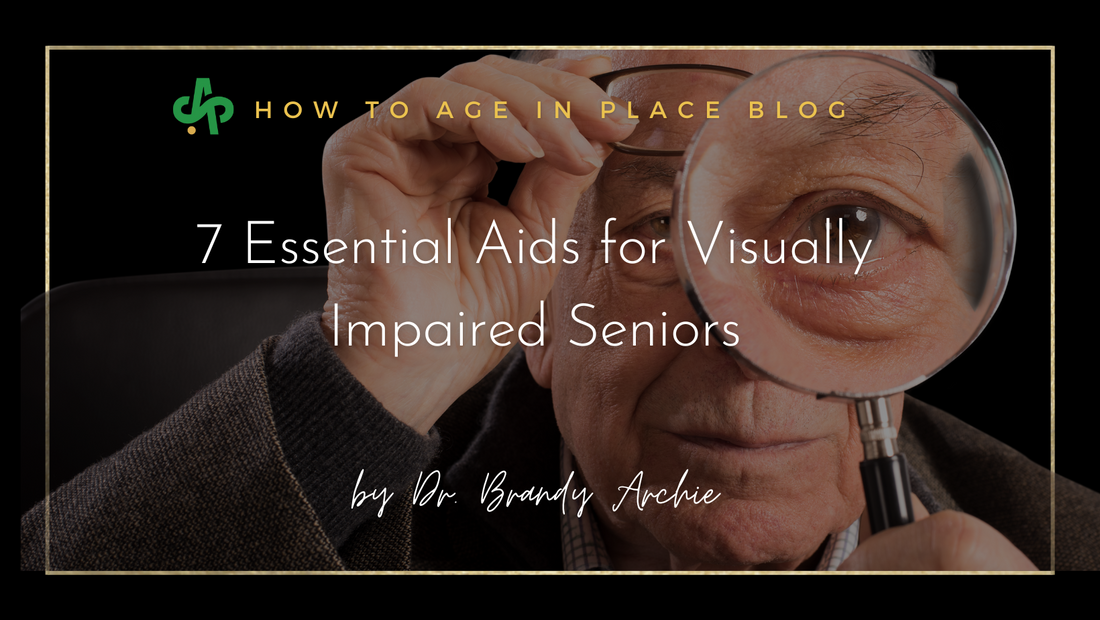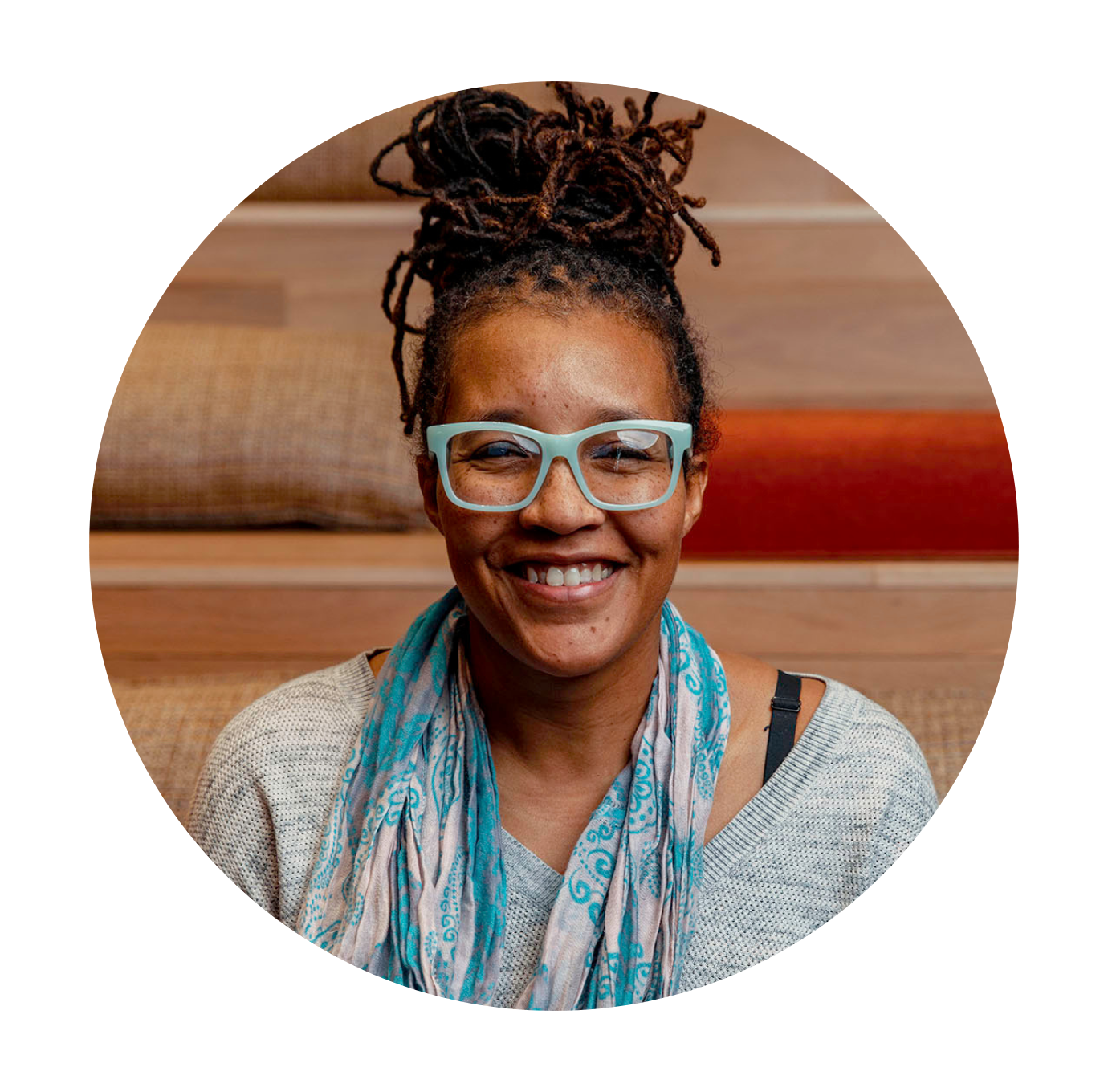As a care partner with a senior with visual impairment, you face unique challenges and responsibilities. It's hard to help your loved one remain independent, safe, and socially connected when they are dealing with vision loss. Fortunately, through our work over the years, we've figured out which low vision aids have been the most needed for seniors with visual impairments. This article is a comprehensive guide to help you understand:
- the common causes of vision loss as we get older
- the effects vision loss has on our lives
- the seven essential aids that can help people remain independent and safe.
Ready for the ride? Let's go!
Most Common Reasons for Visual Impairment in Older Adults
Before you can figure out the right aids for visually impaired seniors, you need to understand the common causes of vision loss. So we'll start there. Age-related macular degeneration (AMD), cataracts, glaucoma, diabetic retinopathy, and retinitis pigmentosa are the five most common causes of vision loss in seniors. Each condition has its own set of risk factors for acquiring the disease and symptoms to look for. Let's dive into each one.
Age-related macular degeneration (AMD)
A deterioration of the part of the retina responsible for central vision. While AMD might not cause complete blindness, it can progress over time and lead to severe visual impairment in which the person may have very little vision beyond recognizing outlines of large shapes and figures. Symptoms include blurry or distorted central vision as well as blind spots in the center of the field of view. Early detection is critical for successful treatment, so be sure to get regular eye exams so symptoms can be caught and treated. Using an Amsler Grid is a great way to detect signs of AMD and to be aware of the progression of the disease after diagnosis. Download a free one from BrightFocus!
Cataracts
A clouding of the eye's natural lens, which blocks light from reaching the back surface of the eye, causing blurred or foggy vision. Cataracts develop slowly over time, but can be accelerated by certain medical conditions, medications, and excessive exposure to ultraviolet (UV) radiation from sunlight or tanning beds. This is the only disease on this list that has a cure. Cataracts can be solved through surgery, where the natural lens is replaced with a plastic lens to restore normal vision. Surgery will only be performed once the issue has worsened significantly. And some people, due to other comorbidities, aren't candidates for surgery at all. The outcome is that many people are affected by cataracts, so visual aids are still important to pursue.
Glaucoma
An increase in pressure inside the eye that damages its optic nerve, leading to gradual vision loss, if left untreated. It may have no obvious symptoms until significant damage has already occurred, so regular checkups with an ophthalmologist are essential for early detection and treatment. Common signs include tunnel-like visual field, halos around lights, redness in eyes, headache/eye pain, nausea/vomiting, and blurred/double vision.
Diabetic retinopathy
Occurs when high blood sugar levels damage blood vessels on the light-sensitive tissue at the back surface of your eye. This can lead to blurry or distorted vision or even total blindness if left untreated for too long. Managing blood sugar well and regular screenings with an eye care professional are essential for preventing and detecting this condition so that it can be treated before permanent damage occurs.
Retinitis pigmentosa
An inherited disorder that affects both eyes equally, resulting in gradual narrowing of peripheral vision, usually during childhood. This is followed by night blindness later in life, eventually leading to total blindness as an older adult if left untreated. Since this condition is genetic, it can't be prevented. But regular treatment with an ophthalmologist can help slow down the progression towards total blindness, significantly increasing quality of life for those affected by this condition.
Effects of Vision Loss on Seniors
Vision loss has a significant impact on seniors' day-to-day lives, and it's important for care partners to recognize and understand these changes. One of the hardest things about visual changes over time is that they are gradual and only one person knows about it - the one seeing through those eyes! So knowing what areas of life low vision can affect helps a care partner recognize signs and start the conversation with the person about these changes. This can help them not feel so isolated and can get interventions started sooner. Here are the most common problems created by a decline in vision:
- challenges with reading
- reduced mobility
- independence with daily tasks
- social isolation
Let's explore each of these in more depth.
Challenges with Reading

Whether it is peripheral vision loss, central vision loss, blurriness, or lack of contrast sensitivity, all of these common symptoms impact the ability to read. Squinting, getting unusually close, or simply asking you to read something for them are all signs that thier vision is changing. There are a ton of ways to maintain the ability to read even as vision gets worse. But the first step is to recognize it!
Reduced Mobility and Safety Risks
Vision loss can have a profound impact on mobility and safety, making it difficult for seniors to get around without assistance. Mobility aids for seniors can be a great help in this regard. Using a walker, even if balance isn't the biggest problem, can give everyone around a signal to provide space for the person. It also means the walker will hit items or notice changes in elevation before the person does, which gives them a little more time to adjust in the case of low vision. If a white cane is needed for navigation due to being close to blindness, we'd highly recommend connecting with an Orientation and Mobility Specialist.
Difficulty Completing Daily Activities and Tasks
For seniors with impaired vision, daily activities are extremely challenging until adaptations are created. Cooking, cleaning, and grooming become difficult when one can't discern colors, patterns, or objects. Reading labels, recipes, or instructions also becomes a great obstacle. Even something as simple as traveling from place to place in the house can be daunting.
We'll dig into our top low vision aids for seniors in just a minute. But the point I want to make is that our lives aren't just made up of the things we have to do. It's truly about the things we like and want to do. So just because someone can navigate in their own home and get something to eat, that isn't the same quality of life as feeling comfortable inviting friends over and cooking for them. These are the same 2 daily tasks - walking and eating. But do you see how different they are? When vision is limited, let's solve for what we like to do, not just want we have to do!
Social Isolation and Depression

Vision loss in seniors can quickly lead to social isolation and depression. When you're uncomfortable in new environments or places where you can't control what's happening, it's easy to just avoid them. That turns into staying home more often and not taking friends and family up on activities outside the house. While the goal might be to stay in the safety and predictability of home, it has the side effect of limiting relationships. Eventually, you start to lose that social network which is so vital for vitality and long-life, which is highlighted so poignantly in the Netflix docuseries Live to 100: Secrets of the Blue Zones.
It's important to make sure that all of us maintain a sense of community and remain socially active. And for seniors with low vision, it may need to be facilitated by providing resources to help them connect with others, such as support groups or online forums. Additionally, make sure they have access to transportation so they can get out and stay connected with friends and family - without feeling like a burden. Find ways that facilitate independent moving around town before it's time to give up driving so a transition can happen.
I cannot exclaim enough how important this is! When you've spent the last 50 years driving where you want to go, when you want to, and then suddenly you can't - it is a devastating loss of independence. Find local programs through your public bus or subway system for transportation. Consider ride share as an option and practice using it together. Help find a friend at church who's willing to pick them up each week so the transportation is built in and doesn't have to be asked for each time. The main thing is to make a plan!
Products For Visually Impaired Seniors
We are going to explore these top 7 low vision aids for seniors we recommend the most and we've seen have the biggest impact! But the range of aids for visually impaired seniors is vast, and varies depending on the individual's visual symptoms and desired daily activities. So we highly recommend you drill down to the low vision aid that'll be helpful to your specific concerns by using our free On Demand Assessment. Answer just a few questions and the results provided will be determined by our clinical expertise. Let's dig in!
-
Your cell phone or tablet
Start with what's already in your pocket! Smart phones, tablets, and computers come with built-in accessibility features that can enlarge text, zoom in on images, and even adjust the color and contrast of the screen. Voice assistants like Siri and Hey Google allow you to access the phone's features by voice, so vision isn't required. So instead of writing appointments on a calendar and struggling to read it, learn to use the phone's calendar to save it and be reminded - all by voice. And because they are connected to the internet, then websites and services that can help with day-to-day activities, such as shopping, banking, are also accessible by voice. -

Bump dots
Small stickers that provide tactile feedback to mark objects in the home. This way, vision isn't required to see small print on buttons throughout the house, like on remotes, stoves, and microwaves. They are a solution that's cost-effective and quick to implement! -

Task lighting
Makes it easier to read small print or work on a computer screen by providing bright lighting directly onto the text or object of focus. Light is usually helpful for most low vision diagnoses, but not just anywhere. When you point the light right towards what's being looked at - instead of at the eyes, it cuts down on glare and improves contrast. So grab a desk lamp and point it at the keyboard or the knitting directly and don't let it shine right in the eyes. -
Large print items
such as books, clocks, or phones are often helpful for low vision aids. They allow people to continue doing the task without having to strain their eyes. Large print doesn't work for everyone, but it is a good place to start because it can be easy to access and low cost. -

Stand magnifiers
Handheld devices that sit flat on the reading material and are set to be the exact height for the clearest look through the magnifier. That way, instead of moving the magnifier back and forth to find the right distance for clarity, it's automatic! They're particularly useful if the users hands are shaky and if over-the-counter magnifiers are no longer strong enough. -
Screen readers & text-to-speech software
Can read text on the screen aloud so that visually impaired seniors can consume written content without straining their eyesight. It works on all types of digital documents, including emails, webpages, and PDFs. This technology is being built into operating systems more often, so check the accessibility settings first. And if not, consider ZoomText or another software to download. Using these programs does take practice, so we'd recommend you connect with an occupational therapist with low vision training to help the person learn to be independent with this tech. -

Desktop digital magnifiers
Provide a high level of magnification, plus multiple contrast options so that anything you can fit under it is easier to see. They range in magnification from 2x to 22x and the large screen size means you still get to see more of the words for context while being zoomed in at a large size. We love for these to sit on a kitchen table or somewhere in the living space, so it's just as easy to sit to read the newspaper as it is to put a canned good under it.
Overall, there's no one-size-fits-all solution to aid visually impaired seniors— each person's needs will be different based on their level of visual impairment and lifestyle requirements. Caregivers should explore all options available to find the best solution for their loved one's specific needs and situation. But don't feel overwhelmed. We're here to help you! Use our free On Demand Assessment to find solutions or connect with us for a virtual visit so one of our occupational therapists can guide you to solutions tailored to the person's needs.



